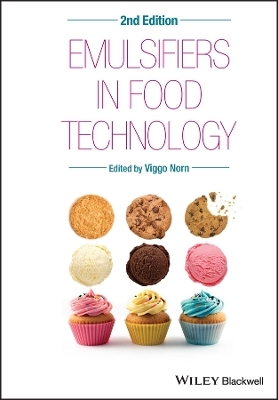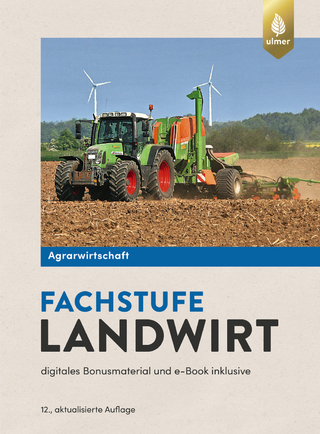
Emulsifiers in Food Technology
Wiley-Blackwell (Verlag)
978-0-470-67063-7 (ISBN)
- Titel z.Zt. nicht lieferbar
- Versandkostenfrei
- Auch auf Rechnung
- Artikel merken
EMULSIFIERS IN FOOD TECHOLOGY Emulsifiers are essential components of many industrial food recipes. They have the ability to act at the interface between two phases, and so can stabilize the desired mix of oil and water in a mayonnaise, ice cream or salad dressing. They can also stabilize gas/liquid mixtures in foams. More than that, they are increasingly employed in textural and organoleptic modification, in shelf life enhancement, and as complexing or stabilizing agents for other components, such as starch or protein. Applications include modifying the rheology of chocolate, the strengthening of dough, crumb softening and the retardation of staling in bread.
Emulsifiers in Food Technology, second edition, introduces emulsifiers to those previously unfamiliar with their functions and provides a state of the art account of their chemistry, manufacture, application and legal status for more experienced food technologists. Each chapter considers one of the main chemical groups of food emulsifiers. Within each group, the structures of the emulsifiers are considered, together with their modes of action. This is followed by a discussion of their production, extraction and physical characteristics, together with practical examples of their application. Appendices cross-reference emulsifier types with applications, and give E-numbers, international names, synonyms and references to analytical standards and methods.
Praise for the first edition of Emulsifiers in Food Technology:
“Very informative … provides valuable information to people involved in this field.” International Journal of Food Science & Technology
“A good introduction to the potential of emulsifiers in food technology … a useful reference source for scientists, technologists and ingredients suppliers.” Chemistry World
“A useful guide to the complicated array of emulsifiers presently available and their main functionalities and applications.” International Dairy Journal
Viggo Norn is Managing Director of Nexus A/S, a company which provides R&D, analytical and legislation-related services to Palsgaard A/S, a global food ingredients company. He is based in Juelsminde, Denmark.
Contributors xiii
Preface to the Second Edition xv
1 Introduction to Food Emulsifiers and Colloidal System 1
Viggo Norn
1.1 Introduction 1
1.2 Food emulsifiers 6
References 18
2 Lecithins 21
Hanns-Georg Bueschelberger, Susanne Tirok, Ilona Stoffels and Arnulf Schoeppe
2.1 Introduction to lecithins and phospholipids 22
2.1.1 Some history 22
2.1.2 Phospholipids 22
2.1.3 Occurrence of phospholipids 24
2.2 Production of lecithins 25
2.2.1 Vegetable lecithin 26
2.2.2 Animal lecithins 27
2.3 Further processing of lecithins 27
2.3.1 Standardization 27
2.3.2 Modifications of lecithins 27
2.3.3 Solvent extraction 30
2.4 Quality aspects of lecithins 33
2.4.1 Acetone-insoluble matter (AI) 34
2.4.2 Toluene-insoluble (TI) 34
2.4.3 Acid value (AV) 34
2.4.4 Peroxide value (PV) 34
2.4.5 Water content (H 2 O) 35
2.5 Physico-chemical aspects of lecithins 35
2.5.1 Solubility in organic solvents 35
2.5.2 Behaviour in water 35
2.5.3 Melting points 36
2.5.4 Surface activity 36
2.5.5 Lecithins and the HLB system 37
2.6 Applications of lecithins in the food industry 38
2.6.1 Lecithin in chocolate, coatings and confectioneries 39
2.6.2 Lecithins in the baking industry 45
2.6.3 Instant technology 50
2.6.4 Emulsions 53
2.6.5 Other applications 58
2.7 Market outlook 59
Acknowledgement 60
References 60
3 Ammonium Phosphatides 61
Viggo Norn
3.1 Introduction 61
3.2 Production of ammonium phosphatides 62
3.3 Physical and chemical properties of ammonium phosphatides 65
3.4 Food applications of ammonium phosphatides 65
3.5 Other food applications 71
3.6 Summary 71
References 72
4 Mono- and Diglycerides 73
Hans Moonen and Henny Bas
4.1 Introduction 73
4.2 The Products 74
4.2.1 Production of monoglycerides 74
4.2.2 Molecular distillation 75
4.2.3 Chemical and physical properties 75
4.2.4 HLB value 76
4.2.5 Addition of antioxidants 76
4.2.6 Legal considerations 77
4.2.7 Behaviour of monoglycerides in the presence of water 77
4.2.8 Nutritional value 79
4.3 Applications 79
4.3.1 Cakes 82
4.3.2 Margarines and spreads 85
4.3.3 Ice cream 86
Acknowledgements 90
References 90
5 Acid Esters of Mono- and Diglycerides 93
Rolf Gaupp and Wolfgang Adams
5.1 E472a (ACETEM) 93
5.1.1 Chemical properties of ACETEM 94
5.1.2 Manufacturing of ACETEM 96
5.1.3 Appearance and physical properties 97
5.1.4 Solubility 97
5.1.5 Phase behaviour 100
5.1.6 Surface-active properties 100
5.1.7 Special properties of ACETEM 100
5.1.8 Safety 101
5.1.9 Typical applications in food 101
5.1.10 Non-food applications 102
5.2 E472b (LACTEM) 102
5.2.1 Chemical properties of LACTEM 102
5.2.2 Manufacturing of LACTEM 105
5.2.3 Appearance and physical properties 106
5.2.4 Solubility 106
5.2.5 Phase behaviour 106
5.2.6 Surface activity 106
5.2.7 Special properties of LACTEM 106
5.2.8 Safety in use 108
5.2.9 Typical applications in food 108
5.3 E472c (CITREM) 108
5.3.1 Chemical properties of CITREM 109
5.3.2 Manufacturing of CITREM 111
5.3.3 Appearance and physical properties 111
5.3.4 Solubility 111
5.3.5 Phase behaviour 113
5.3.6 Surface-active properties 113
5.3.7 Special properties of CITREM 114
5.3.8 Safety in use 114
5.3.9 Typical applications in food 115
5.3.10 Non-food applications 116
5.4 E472e (DATEM) 116
5.5 E472d (TATEM) 116
5.6 E472f (MATEM) 116
5.6.1 Appearance 117
5.6.2 Solubility 117
5.6.3 Safety in use 117
5.6.4 Typical applications in food 118
References 119
6 Diacetyl Tartaric Esters of Monoglycerides (DATEM) and Associated Emulsifiers in Bread Making 121
Rolf Gaupp and Wolfgang Adams
6.1 What are DATEM? 121
6.1.1 Chemical characterization 121
6.2 General properties of DATEM 123
6.2.1 Appearance 123
6.2.2 Thermostability 123
6.2.3 Hydrolysis 125
6.2.4 Storage 125
6.3 Physical and chemical properties of DATEM 125
6.3.1 Physical properties 125
6.3.2 Solubility 126
6.3.3 Mesomorphic phase behaviour 126
6.3.4 Surface-active properties 126
6.3.5 Safety 127
6.4 Typical applications of DATEM in food 127
6.5 DATEM in the baking process 128
6.5.1 Bread making 130
6.5.2 Flour 130
6.5.3 Interaction of DATEM with starch 130
6.5.4 Interaction of DATEM with flour proteins 134
6.5.5 Interaction of DATEM with flour lipids 136
6.5.6 Use and action of DATEM during manufacturing and storage of baked goods 136
6.6 Action of emulsifiers in fine baked goods 138
6.6.1 DATEM in fine baked goods 139
6.7 Summary and conclusions 141
References 142
7 Sucrose Esters 147
Bianca A. P. Nelen, Lia Bax and Julian M. Cooper
7.1 Introduction 147
7.2 Early history of sucrose esters 149
7.3 Production routes to sucrose esters 150
7.4 Purification methods for sucrose esters 153
7.5 Sucroglycerides and sucrose ester detergents 154
7.6 Functional properties of sucrose esters 155
7.6.1 Emulsification 155
7.6.2 Interactions with proteins (gluten, dairy proteins) 155
7.6.3 Interactions with starch 157
7.6.4 Control of sugar crystallization 159
7.6.5 Aeration and foam stabilization 160
7.6.6 Anti-microbial properties 161
7.7 Physico-chemical properties of sucrose esters 162
7.7.1 Solubility 162
7.7.2 pH stability 162
7.7.3 Thermal stability 163
7.7.4 Preparation of sucrose ester solutions 163
7.8 Food applications 164
7.8.1 Dressing and sauces 164
7.8.2 Confectionery 165
7.8.3 Bakery 167
7.8.4 Icings and fillings 169
7.8.5 Ice cream 172
7.8.6 Special emulsions 173
7.9 Legal status 174
7.9.1 Europe 174
7.9.2 USA 174
7.9.3 Canada 176
7.9.4 Japan 176
References 176
8 Polyglycerol Esters 181
Viggo Norn
8.1 Introduction 181
8.2 Legislation 182
8.3 Synthesis of polyglycerol 182
8.4 Synthesis of polyglycerol ester 185
8.5 Properties of polyglycerol esters 188
8.5.1 Stability 188
8.5.2 Physical properties 189
8.6 Food applications of polyglycerol ester 195
8.6.1 Margarines 195
8.6.2 Cakes 198
8.6.3 Shelf life of baked products 202
8.6.4 Creams and toppings 202
8.6.5 Fats 203
8.6.6 Other applications 203
8.7 Conclusion 203
References 204
9 PGPR, Polyglycerolpolyricinoleate, E 476 209
Kim Christiansen
9.1 Introduction 209
9.2 Production of PGPR 210
9.2.1 Synthesis of polyglycerol 210
9.2.2 Synthesis of polyricinoleate 211
9.2.3 Synthesis of PGPR 213
9.3 Legal regulation 214
9.4 Physical and chemical properties of PGPR 215
9.5 Applications of PGPR 216
9.5.1 Application in food 217
9.5.2 Application in non-foods 225
9.6 Conclusion 226
References 227
10 Propylene Glycol Fatty Acid Esters 231
Flemming Vang Sparsø
10.1 Introduction 231
10.2 Chemistry and physical properties 231
10.2.1 Pure, synthetic propylene glycol fatty acid esters 232
10.2.2 Commercial, mixed fatty acid esters of propylene glycol 233
10.3 Production 239
10.3.1 Regulatory status 241
10.4 Food applications 241
10.4.1 Aerated bakery products and cake mixes 241
10.4.2 Sponge cakes, fat-free cakes 243
10.4.3 Dessert products, toppings, non-dairy whipping creams, etc. 244
10.4.4 Ice cream 248
10.4.5 Other applications 249
References 249
11 Stearoyl-2-Lactylates and Oleoyl Lactylates 251
Troy Boutte and Larry Skogerson
11.1 Introduction 251
11.2 Lactylate regulations 252
11.3 Lactylate manufacturing 253
11.4 Lactylate chemistry 257
11.5 Lactylate applications 258
11.6 Interactions between lactylates and starch 258
11.7 Interactions between lactylates and proteins 260
11.8 Lactylates in yeast-raised bakery products and crumb softening 261
11.9 Dough strengthening 262
11.10 Cakes and chemically leavened baked goods 264
11.11 Lactylate use in cookies and crackers 266
11.12 Application of lactylates in pastas 268
References 269
12 Sorbitan Esters and Polysorbates 271
Tim Cottrell and Judith van Peij
12.1 Introduction 271
12.2 Historical development 272
12.3 Production 272
12.3.1 Production of sorbitan esters 272
12.3.2 Production of polysorbates 275
12.4 Physicochemical properties 276
12.5 Emulsifiers in solution 279
12.5.1 Emulsions 279
12.5.2 Molecular arrangement and Critical Micelle Concentrations (CMC) 279
12.5.3 Effect of temperature 280
12.5.4 Protein-emulsifier interactions 281
12.5.5 Solubilization and microemulsions 282
12.6 Applications 284
12.6.1 Fine bakers’ wares 285
12.6.2 Bread 285
12.6.3 Active dry yeast 286
12.6.4 Beverages 286
12.6.5 Dairy 287
12.6.6 Margarine and spreads 288
12.6.7 Chocolate and confectionery coatings 289
12.7 Regulations 289
12.8 Toxicology 292
12.9 Concluding remarks 293
References 293
13 Application of Emulsifiers in Dairy and Ice Cream Products 297
Hanne K. Ludvigsen
13.1 Introduction to dairy technology 297
13.1.1 Milk proteins 298
13.1.2 Fat 298
13.1.3 Other milk constituents 298
13.1.4 Milk processing 299
13.2 Emulsifiers in dairy applications 299
13.2.1 Recombined milk 300
13.2.2 Imitation whipping cream 300
13.2.3 Powdered coffee whitener 301
13.3 Emulsifiers in ice cream 301
13.3.1 Composition of ice cream 302
13.3.2 Functionality of emulsifiers in ice cream 303
References 308
14 Regulation of Food Emulsifiers in the European Union 309
Frances Hunt
14.1 Safety evaluation of food emulsifiers 309
14.2 Authorization of food emulsifiers 311
14.3 Food additives in food emulsifiers 317
14.4 Purity criteria for food emulsifiers 317
14.5 Labelling of food emulsifiers 317
References 319
15 Analysis of Emulsifiers 321
Lars Preuss Nielsen
15.1 Introduction 321
15.2 Official methods 321
15.2.1 Wet chemical methods 322
15.2.2 Physical methods 324
15.2.3 Instrumental methods 326
15.3 Advanced analytics 328
15.3.1 Molecular spectroscopy 329
15.3.2 Chromatography 331
15.3.3 Mass spectrometry 332
15.4 Choosing the analytical technique 333
References 334
Index 337
| Verlagsort | Hoboken |
|---|---|
| Sprache | englisch |
| Maße | 175 x 252 mm |
| Gewicht | 862 g |
| Themenwelt | Technik |
| Weitere Fachgebiete ► Land- / Forstwirtschaft / Fischerei | |
| ISBN-10 | 0-470-67063-0 / 0470670630 |
| ISBN-13 | 978-0-470-67063-7 / 9780470670637 |
| Zustand | Neuware |
| Informationen gemäß Produktsicherheitsverordnung (GPSR) | |
| Haben Sie eine Frage zum Produkt? |
aus dem Bereich


